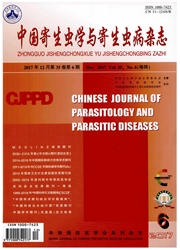

 中文摘要:
中文摘要:
目的分析套式PCR(nest-PCR)和限制性内切酶片段长度多态性(PCR-RFLP)方法在恶性疟原虫地理株裂殖子表面蛋白(MSP2)基因多态性研究中的分型效率及特异性。方法分别在海南省三亚市和云南省腾冲县等地通过静脉采血法采集疟疾患者血样98份,其中恶性疟88份,间日疟10份。另从上海地区的健康人群中抽取10份血样作为阴性对照。用nest-PCR和PCR-RFLP方法分别对疟原虫地理株进行MSP2等位基因分型,并对分型结果进行归纳和比较分析。结果常规nest-PCR方法对于恶性疟原虫地理株MSP2等位基因的总检出效率为79.8%(166/208),其中,对于FC27家族等位基因的检出效率为92.7%(101/109),但对3D7家族等位基因的检出率仅为65.7%(65/99),且无法鉴定具体的等位基因。PCR-RFLP分型法检出效率比nest-PCR法提高了20.2%,且特异性好。结论PCR-RFLP相对于常规的nest-PCR分型法具有检出效率、分辨率和特异性皆高的优点,可以鉴定地理株中具体的等位基因类型。
 英文摘要:
英文摘要:
Objective To analyze the efficiency and specificity of MSP2 alleles genotyping for Plasmodium falciparum isolates by Nest-PCR and PCR-RFLP. Methods MSP2 alleles from Plasmodium falciparum isolates of Yunnan and Hainan were genotyped by Nest-PCR and PCR-RFLP, respectively, and the efficiency and specificity of the two methods were analyzed. Results The conventional Nest-PCR method could detect 79.8% (166/208) alleles of MSP2, and 65.7% (65/99) for 3D7 family, but could not identify the type of any allele. While PCR-RFLP showed 25.3% higher genotyping efficiency than Nest-PCR. Moreover, this method could identify the allele types. Conclusion PCR- RFLP genotyping technique is more efficient and specific than conventional Nest-PCR, and it is a convenient tool in the study on molecular epidemiology of malaria.
 同期刊论文项目
同期刊论文项目
 同项目期刊论文
同项目期刊论文
 期刊信息
期刊信息
